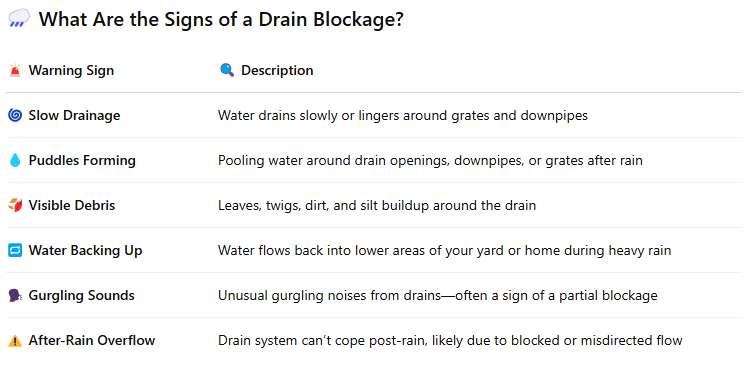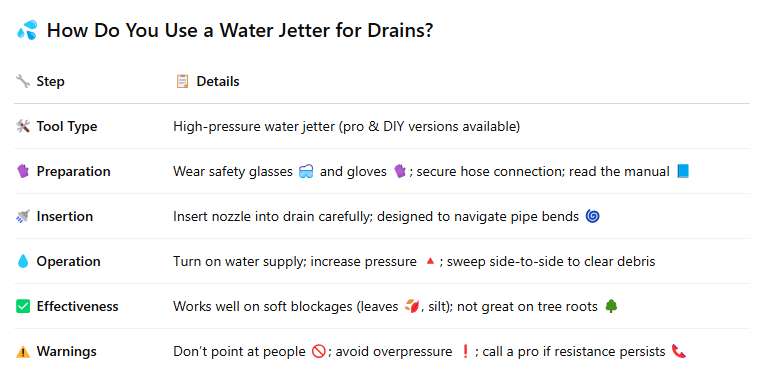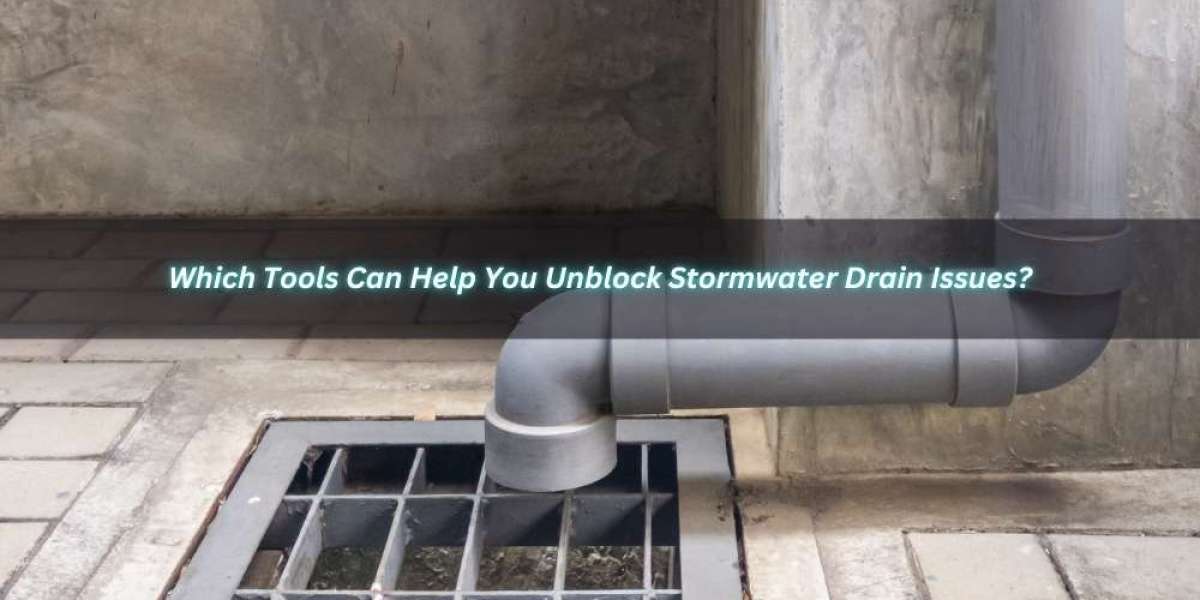Is the unending Sydney rain making parts of your property feel like waterfront property? This pooling water after a downpour is a common frustration for homeowners and businesses throughout the city. As often as not, the offending agent is a blocked stormwater drain, preventing the adequate drainage of rainwater. One of the essential things to focus on is addressing potential blocked stormwater drain repairs before a minor issue escalates into a costly emergency, spotting these warning signs early, and knowing how to respond to save you significant water damage. This article will explain minor stormwater blockages and how to fix them when you encounter them. Our guide will show you common signs of a blocked drain, highlight essential preventative maintenance strategies, and explain, most importantly, the easy-to-use tools you already have for stormwater drain unblocking before they become a more costly problem. This information will give you the tools to handle minor drainage issues confidently and ensure that the area around your property stays dry and safe.
What are the signs of a drain blockage?
Knowing the warning signs of a clogged stormwater drain can protect you from a great deal of stress. You may see it lingering rather than water going down the drain quickly. A primary way to tell is having puddles collecting around downpipes or grates. You might even notice debris such as leaves, twigs, and dirt build up around the drain opening. Suppose the blockage is further down after heavy rain. In that case, you may see water backing up into lower areas of your property. A gurgling noise from your drains may also indicate a partial blockage. These issues often arise from unmanaged water from rain that flows off a house, which should be appropriately directed through your drainage system. Being mindful of these signs—especially during and after rainfall—is the first step towards preventing more serious issues.

What simple tools can you use to fix small drain clogs?
A few standard household tools are often all you need to remove a minor blockage.
- Gardening gloves protect your hands as you remove debris from the drain opening with either hand or a tool.
- Hand trowel or scoop: If you need to remove leaves, soil, or other loose material that has built up, hand trowels or even a small scoop for extra debris can help.
- Plunger: The same tool you use for a jammed toilet can sometimes create enough sucking force to dislodge minor blockages in stormwater drains, especially those closer to the surface. There needs to be enough standing water to make a good seal.
- Drain snake or auger: A manually powered drain snake or auger can be used on clogs located further down. This pliable tool is inserted into the drain and twisted to break up or retrieve the blockage. Most hardware stores sell these.
- Stiff brush: A heavy-duty brush can help scrub off accumulated muck and minor debris from around the drain opening and the inside of the pipe.
- Garden hose: A garden hose with a spray nozzle can clean out any loose debris. Aim for the water jet to go towards the drain to loosen the clog.
You want to work slowly and use the correct tools for the job—forcing tools to be too stiff can damage your drain pipes.
What's needed for basic drain maintenance?
Fixing blockages is always worse than preventing them. Honing a few simple maintenance habits helps. You want to regularly remove leaves, twigs, and other debris that builds up around your drain openings. So, you’ll definitely need a good pair of durable gardening gloves to get you through this task. A small hand trowel or scoop can also assist in gathering the muck. You may consider using a drain guard or a leaf catcher on your downpipes and grates. These simple devices work like a sieve, catching more considerable debris before it can enter drainage systems. Check and empty these guards periodically, especially before and after heavy rains. By staying active, individuals can buy time and significantly lower the chances of a minor blockage.
How do you use a water jetter for drains?
A water jetter is a more robust tool that forces high-pressure water through blockages. Although you can rent professional-grade jetters, smaller, less expensive models are available for home use. These usually connect to your garden hose.

- Preps: Always wear safety glasses and gloves when working with water. Make sure the hose is tight and follow the manufacturer’s instructions strictly.
- Insertion: Carefully insert the jetter hose into the drain opening using its nozzle. Some jetters have a specialised nozzle that assists them in maneuvering bends in the pipe.
- Procedure: With a sheer open supply, increase pressure at will. The force of high-pressure water will remove and wash away debris. More from: Use the hose to sweep side to side to remove the entire pipe section.
- Warning: Never point the jetter toward yourself or others. Don't over-pressurise lines, especially older or more delicate pipes. If you encounter dramatic resistance, my advice is to back off and consider calling in a professional.
Water jetters beat the blockages they can hold out on blows against much softer blockages, like silt and leaves. But they may not be effective at something like tree roots.
What are the signs I should call a plumber for drains?
DIY methods often work on simple blockages, but a licensed plumber is best for some situations. If you’ve used those simple tools and the blockage remains, that could signify a more significant problem. This might include:
- Severe blockages: If water is backing up a lot or refusing to drain, your attempts at clearing it have failed.
- Frequent blockages: If your drains are regularly blocked, this could suggest a problem with your drainage system, such as broken pipework or tree roots growing into your pipes.
Bad smells: Continuous foul odours from your drains may be a warning sign of a more serious sewage blockage. - Damaged pipes: If you think your stormwater pipes are cracked, broken, or misaligned.
Tree roots: When suspected tree roots invade pipes, professional tools and knowledge are typically necessary to clear them effectively. - Inexperience: If you're unfamiliar with using drain-clearing tools or aren't sure why the drain is clogged, contacting a pro is always safer.
A qualified plumber has the experience, specialised tools (such as CCTV drain cameras), and knowledge to accurately diagnose the issue and implement an effective, long-term solution. However, applying an imperfect solution to a complex blockage that requires a more specialised and defined process can result in damages. If you're facing persistent drainage issues, it's best to consult experts in plumbing issues of your house to ensure a thorough and effective fix.
Conclusion
Another soggy nuisance is a blocked stormwater drain. But you can handle minor clogs by identifying the common symptoms, practising routine maintenance, and having a few simple tools available. Also, gardening gloves, a trowel, a plunger, a drain snake and a garden hose might be your first line of defence. If you use a water jetter, proceed safely and follow instructions. But if the clog is especially handling a more serious underlying issue, don't hesitate to get a qualified plumber. Keeping on top of your stormwater drainage can minimise the risk of water damage to your property and prevent your backyard from becoming a surprise swimming pool after every Sydney downpour. For a more proactive approach, consider to check for our guide on full plumbing health checks to stay ahead of hidden issues.


